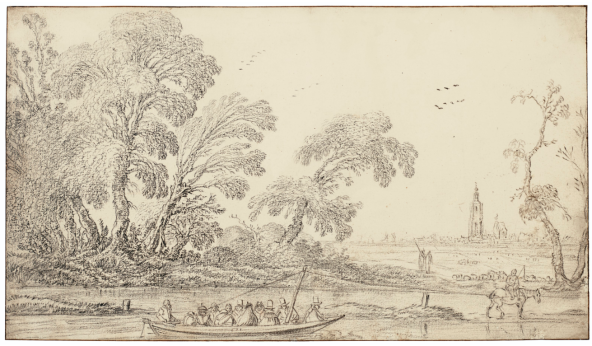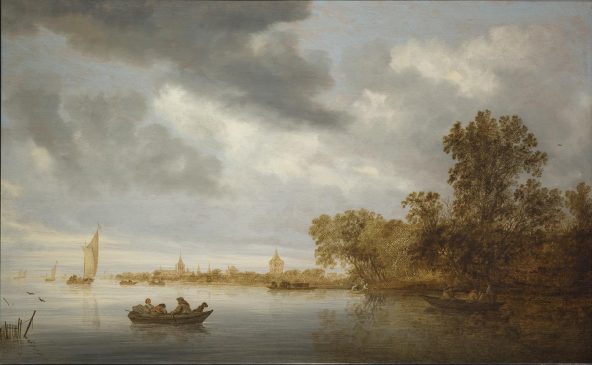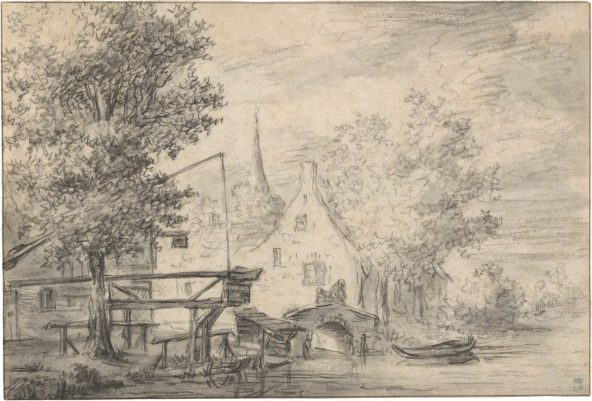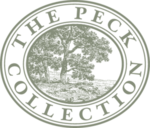Article: Water in Seventeenth-Century Dutch Landscapes
Focus on the Peck Feature
During the seventeenth century, the Dutch Republic undertook intensive land reclamation projects using a complex system of dikes and drainage to increase their land mass. This resulted in the creation of new inland lakes, rivers, and a system of canals used for commerce, transportation, and leisure. Looking to the natural world for inspiration, Dutch artists depicted water in all its forms — from broad seascapes to lakes, rivers, canals, and even ditches, often demonstrating the wide range of human activity undertaken on or alongside waterways. This Focus on the Peck Collection installation features works by Esaias van de Velde, Salomon van Ruysdael, and Jacob van Ruisdael, three generations of artists whom each depict an important aspect of water and its uses.
Throughout history, the Dutch have maintained a unique and physical relationship with their water and land. The name of their country, The Netherlands in English, or Nederlands (Low Countries) in Dutch, aptly describes its low-lying elevation at or even below sea level. During the seventeenth century, the Dutch Republic undertook intensive land reclamation projects using a complex system of dikes and drainage to increase their land mass. This resulted in the creation of new inland lakes, rivers, and a system of canals used for commerce, transportation, and leisure. As the popular Dutch saying relates, “God created the world, but the Dutch created Holland.”
Looking to the natural world for inspiration, Dutch artists depicted water in all its forms — from broad seascapes to lakes, rivers, canals, and even ditches, often demonstrating the wide range of human activity undertaken on or alongside waterways.
This Focus on the Peck Collection installation features works by Esaias van de Velde, Salomon van Ruysdael, and Jacob van Ruisdael, artists from three generations whom each depict an important aspect of water and its uses. Closely connected by the city of Haarlem, a significant center of landscape production roughly twenty miles west of Amsterdam, they each considered their local environment as an important source of inspiration and pride.
A Landscape with a Horse-drawn Ferry, the City of The Hague with the Grote Kerk Beyond

Esaias van de Velde, Dutch, 1587 – 1630, A Landscape with a Horse-drawn Ferry, the City of The Hague with the Grote Kerk Beyond, c. 1618 – 19, black chalk, pen and brown ink on paper, Anonymous Loan, L2022.12.41.
Christie’s New York
Trekvaarten, or towing canals, were an important means of inland water transportation in the Dutch Republic. During the seventeenth century, approximately 400 miles of straight canals were created to accommodate horse-drawn barges for passengers. Before the establishment of regular routes in 1632, only a few ferries offered regular service. Esaias van de Velde’s drawing of about 1618 or 1619 shows an early example.
In the foreground, twelve travelers are pulled by a single-manned horse and steered by the figure holding a rudder at the rear of the boat. A narrow strip of land separates them from a tall stand of trees and a distant view of The Hague featuring the spire of the Grote Kerk, or Great Church. Van de Velde moved to the city in 1618 after establishing himself as a leading landscape artist in Haarlem.
Van de Velde’s use of chalk for drawings of outdoor scenery, which enhanced atmospheric effects, was especially influential among his contemporaries.
River Landscape with Fishermen

Salomon van Ruysdael, Dutch, c. 1602 – 1670, River Landscape with Fishermen, 1643, oil on panel, The William A. Whitaker Foundation Art Fund, 2002.15.
See River Landscape with Fishermen in more detail here.
Passenger boats, barges, and sailing and fishing vessels, glide smoothly across the still water of Salomon van Ruysdael’s quiet river scene. Although Van Ruysdael’s depiction is likely not a literal view, some scholars have identified the village with multiple church spires in the distance as Vianen, located on the Lek River in the province of Utrecht. Whether the scene is real or imagined, the artist expresses an important aspect of Dutch national pride — the use of water for transportation and commerce. Such scenes were especially popular amongst collectors purchasing works on the expanding, open art market and brought Van Ruysdael a high degree of success in Haarlem, a city known for its landscape production.
Riverbank with a Wooden Aqueduct and View of a Village

Jacob van Ruisdael, Dutch, 1628/9-1682, Riverbank with a Wooden Aqueduct and View of a Village, c. 1650, black chalk and gray wash on paper, 6 3⁄16 × 9 3⁄16 in. (15.7 × 23.3 cm). Ackland Art Museum, University of North Carolina at Chapel Hill. The Peck Collection, 2017.1.74.
See Riverbank with a Wooden Aqueduct and a View of a Village in more detail here.
At the river’s edge, a wooden deck and aqueduct have been constructed to transport fresh water to the inn, tavern, or brewery at the left. A hoist, balanced between the fork of an oak tree trunk, is used to lift buckets and direct the water flow along the elevated channel connected to the building above the door. To the right, a family of three, having just docked their boat, stands on the small stone bridge, perhaps on their way to this establishment.
Jacob van Ruisdael depicted various mechanical, wooden waterway constructions and mills in his drawings of this early period in his career. The artist likely trained with his uncle Salomon van Ruysdael during his youth in Haarlem before establishing himself in Amsterdam, where he emerged as the most accomplished landscape artist of the later seventeenth century.
